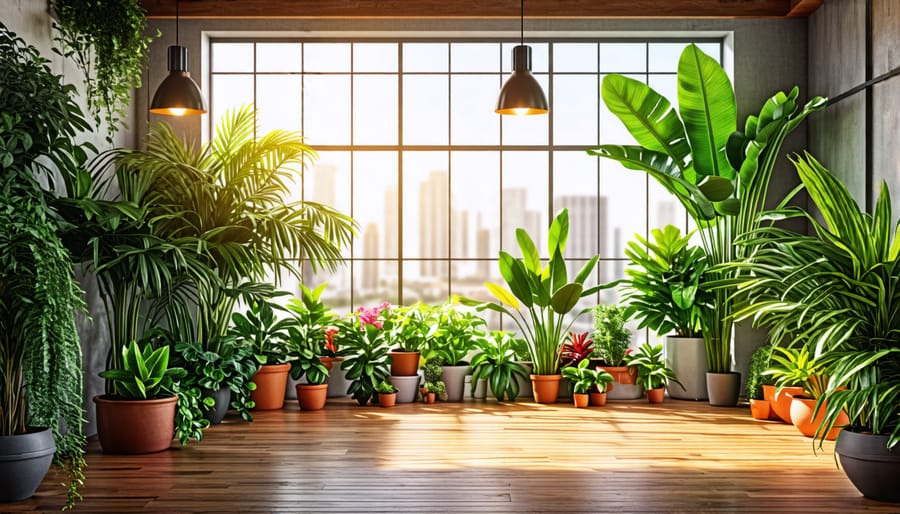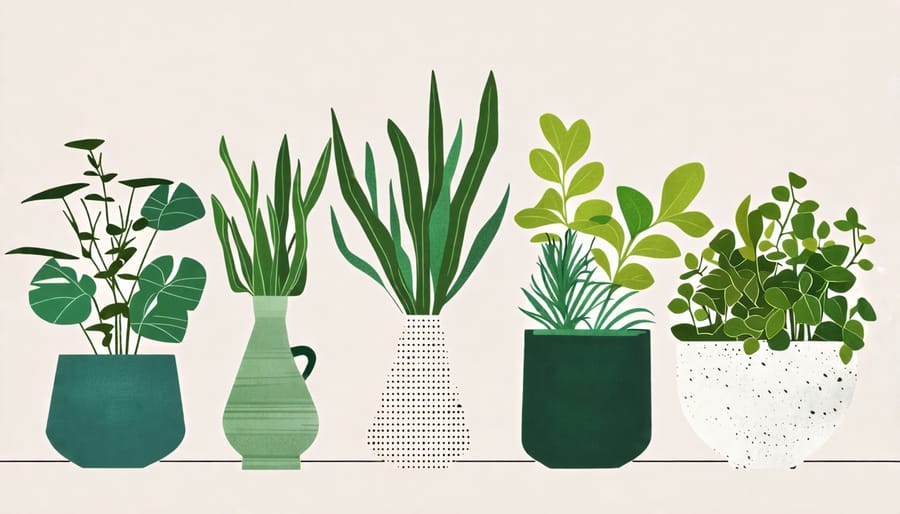Brighten up your space by hanging macramé plant holders from the ceiling for a stylish and airy feel. Choose low-maintenance plants like pothos or snake plants that thrive indoors, providing lush greenery with minimal effort. Create a focal point by grouping plants of varying heights on a windowsill or shelf, using stylish pots for a cohesive look. Incorporate DIY projects by repurposing old jars as mini planters or crafting custom plant stands to elevate your greenery.
Understanding Your Indoor Environment
Lighting Considerations
When it comes to decorating with indoor plants, lighting is a key factor that can significantly impact plant health and aesthetics. Each plant species has its own lighting needs, so understanding these will help you create a thriving green space. For instance, succulents and cacti thrive in bright, direct sunlight, while ferns and peace lilies prefer indirect, lower light conditions. Consider positioning your plants near windows that offer the right amount of light they require. East or west-facing windows are ideal for medium-light plants, while south-facing windows suit those craving direct sunlight. If natural light is scarce, don’t worry; you can use grow lights to supplement. Experiment with placement to not only enhance plant growth but also to aesthetically balance the room, ensuring a vibrant and welcoming indoor oasis.

Space and Size
When it comes to decorating with indoor plants, selecting ones that suit your space ensures they enhance, rather than dominate, your room. Start by assessing your available space; smaller areas benefit from plants like succulents or air plants, which thrive in compact pots or hanging displays. For larger spaces, consider a striking fiddle leaf fig or a graceful peace lily to create a natural focal point. Remember, placement is key: tall plants can visually heighten a room when placed in corners, while a trailing pothos adds charm when cascading from shelves. To prevent clutter, stick to a harmonious color palette with your pots and planters, and consider layering plants of varying heights for a well-balanced look. By thoughtfully balancing plant size with your living space, you can transform any room into a vibrant, inviting sanctuary.
Choosing the Right Plants for Decoration
Low-Maintenance Options
If you’re just starting with indoor plants or have a packed schedule, opt for low-maintenance varieties that bring life to your space without demanding constant attention. Snake plants are a top choice—they thrive in low light and need minimal watering, making them perfect for forgetful gardeners. Equally fuss-free is the ZZ plant, known for its ability to tolerate neglect while still looking lush and green. For a splash of color, consider a pothos plant; its adaptable nature allows it to flourish in various lighting conditions. Incorporating these hardy plants will effortlessly transform your home into a verdant retreat.
Statement Plants
Transforming your space with statement plants is like adding a striking piece of art—instantly captivating and full of personality. Consider the elegant monstera with its large, dramatic leaves that evoke a lush, tropical vibe. Or try a fiddle leaf fig, beloved for its grandeur and bold presence. These plants serve as natural focal points in any room, adding depth and sophistication. For something truly unique, the sculptural snake plant features tall, architectural foliage perfect for modern interiors. Position these plants where they can command attention, and watch them breathe life into your decor, turning your home into a green sanctuary.
Styling Tips for Indoor Plants
Using Pots and Planters
Choosing the right pots and planters can transform your indoor plants into stunning decor elements. Begin by selecting pots that complement your home’s style—think sleek, minimalist designs for modern interiors or rustic, textured pots for a cozy, homely feel. The pot’s color, texture, and material play a crucial role in enhancing your plant’s natural beauty. For added flair, consider varying the pot sizes and heights to create a dynamic visual arrangement. Using hanging planters or tiered stands adds dimension, making your green companions a focal point of any room. Remember, the beauty lies in balance, so mix and match creatively to find a harmonious blend.
Integrating Plants in Living Spaces
Transform your living spaces effortlessly by adding plants that not only beautify but also purify air. In the living room, consider suspended pots or a vibrant green shelf for a modern twist. Explore living wall ideas for a dynamic focal point. In kitchens, sprinkle herbs like basil or mint in cheerful pots—functional and decorative! Bathrooms thrive with humidity-loving plants like ferns or orchids. Don’t hesitate to get creative with plant stands or macramé hangers for a touch of personality. Remember, the key is balance, ensuring each plant complements your space.
The Art of Plant Grouping
Bringing your indoor plants together can transform ordinary spaces into vibrant, living artworks. Start by choosing plants with varying heights and leaf textures to create depth. For an eye-catching display, place taller plants, like fiddle leaf figs, behind medium-sized ones, such as snake plants, and finish with smaller succulents in the foreground. Grouping plants in odd numbers often feels more natural to the eyes, so aim for trios or quintets. Use planters of different styles and colors that complement your overall decor to enhance visual interest. Experiment with layering plants on shelves or stacking them with stands to add dimension to your indoor garden.
DIY and Upcycling Ideas for Plant Decor
DIY Planter Projects
Transform your home’s greenery with these simple DIY planter projects. Start by repurposing an old wooden crate or a colorful metal tin into a unique planter. Begin by drilling small drainage holes at the bottom, then line it with a breathable fabric like burlap. Next, fill it with a mix of potting soil and your favorite indoor plants. For a more personalized touch, consider painting your container using colors that complement your home decor. Another idea is to use a string of twine to hang small glass jars, turning them into charming hanging planters; this not only saves space but adds a vertical dimension to your plant display. Whether you want a rustic or modern look, these easy projects can elevate your indoor plant game, making it both fun and stylish.

Recycling Household Items
Transforming household items into plant containers is a delightful way to decorate while honoring your eco-friendly values. Picture a vintage teapot cradling a lush fern on your kitchen counter, or mismatched coffee mugs reinvented as quirky succulents pots. Old tins, lined with pebbles for drainage, offer charming homes for aromatic herbs or small flowers. Even a worn colander can become an eye-catching hanging planter, perfect for trailing plants. For a touch of whimsy, consider an old pair of boots or quirky baskets, lined with a waterproof layer, to add character and color. These ideas not only give your plants a unique home but also breathe new life into items that would otherwise gather dust. Try mixing different textures and colors for an eclectic yet harmonious display, turning your home into an inviting green sanctuary.
Expert Tips and Common Pitfalls
Maintaining Plant Health
Keeping your indoor plants healthy is easier with a few simple habits. Start by ensuring each plant has the right light; check whether they prefer sunny spots or shade. Water them according to their needs—overwatering is a common mistake, so let the topsoil dry before the next drink. Dust leaves gently with a damp cloth to allow better sunlight absorption, boosting photosynthesis. Feed them with a balanced, liquid fertilizer every few weeks during growing seasons. Rotate plants occasionally so they grow evenly. Lastly, watch for any signs of pests or disease early on, to address problems before they spread. By following these tips, your green companions will thrive beautifully.
Avoiding Design Missteps
When decorating with indoor plants, balance is key to avoid design missteps. Start by visualizing how the plants fit with your existing decor style, ensuring harmony rather than chaos. Consider the size and placement of each plant; a mix of heights and textures can add interest without overcrowding. Aim for a cohesive look—think about how colors and pot styles complement rather than clash. Also, remember that less is often more: a few well-chosen plants can make a significant impact without overwhelming the space. For ideas on maintaining harmony and sustainability, explore eco-friendly decor tips.
Conclusion
Bringing indoor plants into your living space not only adds beauty but also fosters a nurturing atmosphere that can truly make your home cozy. By selecting the right plants and employing creative DIY projects, you can easily elevate your home’s decor. From hanging arrangements to tabletop displays, the possibilities are endless. Remember, choosing plants that suit your environment and lifestyle is key. So, take these insights and tips to heart, and start experimenting today. You’ll find that integrating a bit of greenery into your home is both rewarding and transformative.
